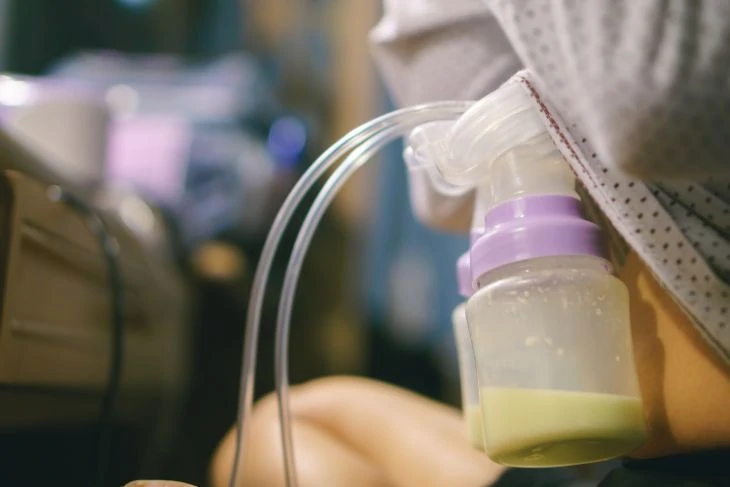The thought of pumping milk at work can feel overwhelming.
For many moms, dragging a breast pump to the office and finding a private corner to use it sounds intimidating.
While it might feel awkward at first, pumping at work is your right. It ensures you can continue providing liquid gold for your baby even when you aren’t together.
If you feel nervous about your return to the office, we have the survival guide you need to pump with confidence.
Back to Work Pumping Checklist

Know Your Rights

Breastfeeding at work can be tricky, but if anyone gives you a hard time, remember that the law is on your side.
Discussing breastfeeding options with a boss makes many women uncomfortable. When I returned to work, I was timid. But I had a fearless coworker who insisted on proper break times and a sanitary room.
You might not have a trailblazer in your office, so you may have to assume that role. Some companies still don’t fully value the role of breastfeeding, so we have to advocate for ourselves.
Here is what you need to know about your rights under the PUMP for Nursing Mothers Act and the FLSA (Fair Labor Standards Act):
- Who is covered: Thanks to the PUMP Act passed in 2022, protections now extend to nearly all employees, including salaried workers, teachers, and nurses (1).
- How it helps: Medical professionals agree breast milk provides superior nutrition. This law forces employers to provide break time for you to pump breast milk for one year after your child’s birth.
- The rules: Your employer must provide a private place to pump that is not a bathroom. It must be free from intrusion from coworkers and the public.
- Who enforces this: The U.S. Department of Labor’s Wage and Hour Division watches over this law. If you experience violations, you can call 1-866-487-9243.
- Time limits: The law states you get a “reasonable” amount of time. You generally aren’t paid for this time unless you pump during an otherwise paid break or if you are working while you pump.
Pumping at Work Timeline Checklist

Preparation is your best friend. Here is a timeline to help you get ready before your first day back.
One Month Before Returning to Work:
- Build a stash: Start freezing breast milk. Aim for 25 to 30 ounces, which covers about one day of feedings. Pump for a few minutes after your baby nurses to collect small amounts that add up quickly.
- Chat with your boss: confirm the room you will use for pumping and discuss any necessary schedule adjustments.
- Choose child care: Select a provider who supports your breastfeeding goals and understands how to handle breast milk properly.
One Week Before Returning to Work:
- Check your gear: Ensure you have all necessary pump parts, bottles, and bags.
- Do a trial run: Practice your new morning routine. You might even invite your caregiver over for a test run while you step out of the house.
First Week Back at Work:
- Expect emotions: Leaving your baby is tough. You might feel guilty or weepy. This is completely normal.
- Maintain supply: Pump regularly to prevent clogged ducts and keep your production high.
- Be flexible: You will likely face curveballs. Keep your chin up; the first week is usually the hardest.
Setting Up a Workable Schedule

Balancing work and pumping takes practice. You will get better at juggling it all as you go.
Use this checklist to keep your day flowing smoothly:
The Night Before:
- Clean your breast pump and bottles.
- Sanitize parts if that is part of your routine.
- Pack your lunch, snacks, and pump bag. Lay out your clothes to save time in the morning.
Before Leaving in the Morning:
- Breastfeed your baby right before you leave.
- Pump any remaining milk if the baby didn’t drain your breasts.
- Pack your pump, containers, and ice packs in your breast milk cooler.
- Ensure there is enough milk in the fridge for the caregiver so you don’t have to dip into your frozen stash.
On the Clock:
- Stick to your schedule. Ideally, pump every three hours (or as often as baby eats). Never go past four hours to avoid leaks and engorgement.
- Wash your hands before handling any pump parts.
- Relax. Stress inhibits letdown. Look at photos of your baby or smell a piece of their clothing to help the milk flow.
- Rinse pump parts or store them in a clean bag in the fridge between sessions (the “fridge hack”) to save cleaning time for home.
Reuniting with Baby:
- Breastfeed as soon as you see your baby. If you can’t do it at daycare, feed them in the car or immediately upon getting home.
At Home:
- Label and refrigerate the milk you pumped at work immediately.
- If the baby will eat it within 3-4 days, refrigerate it. Otherwise, freeze it.
- Breastfeed on demand throughout the evening.
- Prioritize skin-to-skin contact. Your baby missed you and needs that connection just as much as you do.
What's A Good Schedule For Pumping At Work?
Every job is different, but this sample schedule works for many 9-to-5 moms:
- 6:30 a.m. Breastfeed at home before leaving.
- 8:30 a.m. Breastfeed at child care or right before you head out the door.
- 11:30 a.m. Pump during your lunch break.
- 2:30 p.m. Pump during an afternoon break.
- 5:30 p.m. Pump before leaving work OR breastfeed immediately upon pickup.
- 8:00 p.m. Breastfeed before bed.
- 1:00 a.m. Night feeding (prolactin levels are high at night, which helps supply).
Consider yourself on a 12-hour shift. If you are away for 8-9 hours, you generally need to pump roughly 3 times to mimic your baby’s feeding schedule.
Teachers tend to have a hard time, too, since it’s not always easy to get away from the classroom to find time to pump. You may find your profession has unique challenges, as well. Talking to other moms at your workplace can help you find workable solutions to any problems you encounter that are particular to your job or employer.
Editor's Note:
Michelle Roth, BA, IBCLCTips to Help You Make the Transition

Going back to work while breastfeeding is a major challenge, even for the most prepared moms.
You have to think ahead and troubleshoot problems as they arise.
I spent weeks feeling like I was on the verge of a breakdown. I would lie in bed mentally running through checklists, terrified I had forgotten a bottle or a valve.
It gets easier. The first few weeks are the hardest hurdles.
Here are tried-and-true tips to make the transition smoother.
1. Choose the Right Pump
Your pump is your teammate. If you choose wisely, it does half the work for you.
For working moms, a high-quality double electric breast pump is non-negotiable. You need efficiency and speed.
Consider these factors when shopping for the best breast pump:
- Noise level: You don’t want your coworkers hearing a loud rhythmic “whoosh” through the wall. Look for quiet motors.
- Speed settings: Adjustable suction and cycle speeds help you trigger a letdown faster and maximize output.
- Portability: If you are hauling it back and forth daily, a heavy pump will get old fast.
- Power source: Does it have a battery pack? If your pumping room doesn’t have an accessible outlet, a battery-operated pump is a lifesaver.
2. Relax to Flow
Stress is the enemy of milk production. If you are tense, your body won’t let down.
Try to zone out. Ensure you are warm and comfortable. Distract yourself with a funny video, scroll through photos of your baby, or play a game on your phone. Disconnecting from “work mode” for just 15 minutes can make a huge difference in your output.
3. Master Multitasking
If you can’t step away completely, multitask.
Use a hands-free pump or a pumping bra. This frees up your hands to eat lunch, answer emails, or type. Nutrition is vital for milk production, so use this time to eat if you can’t take a separate lunch break.
4. Invest In a Good Cooler
A reliable portable cooler is essential for transporting your liquid gold safely.
Since you likely won’t use the milk until the next day, start chilling it immediately (2). Use plenty of ice packs. If your office has a fridge, you can store your labeled bag there, but a personal cooler keeps your milk private and ready to grab when you clock out.
5. The “Fridge Hack”
Life Saver
Note: The CDC recommends washing parts after every use, especially for preemies or immunocompromised babies, but many working moms swear by the fridge method for healthy, full-term infants.
6. Scout Your Location
If your designated room is a supply closet with no outlet, talk to HR. You don’t need a luxury suite, but you do need a chair, a flat surface, privacy, and electricity.
Be polite but firm. The law requires a space that is not a bathroom. Advocating for yourself is good practice for advocating for your child later.
7. Stay Organized
dedicate one specific pump bag for work. Keep it packed with your pump, spare parts, cooler, wet wipes, and extra storage bags.
Pack it the night before so you can grab it and go. You don’t want to realize you forgot a valve when you are sitting in your car at the office.
8. Protect Your Supply
Do not skip pumping sessions. If you miss sessions, your body thinks your baby doesn’t need the milk, and your supply will drop.
Eat enough calories and drink plenty of water.
Letdown Hack
9. Manage Stress
Returning to work is exhausting. You are doing two full-time jobs.
To keep your cortisol levels down:
- Delegate: Ask your partner to wash pump parts or pack lunch.
- Move: Even a short walk can clear your head.
- Plan: Do not leave tasks for the morning.
- Arrive early: Get to work 10 minutes early to set up your station so you aren’t rushing later.
- Snack smart: Keep protein-rich snacks at your desk.
10. Handle Business Travel
If you travel, ask your employer about milk shipping services like Milk Stork, or plan to carry your milk home.
Even if you can’t bring the milk back, you must pump to maintain supply. It is painful to “pump and dump,” but it preserves your ability to breastfeed when you return.
11. Prioritize Sleep
“Downtime” is a myth for new moms, but sleep is crucial.
Cut caffeine after 2 p.m. to ensure you can fall asleep quickly. On weekends, trade shifts with your partner so you can catch a few extra hours of rest.
12. Reconnect at Home
Breastfeeding is about more than food; it is about connection.
When you are home, keep your baby close. Nurse on demand and get plenty of skin-to-skin time. This boosts your oxytocin levels, which helps your supply and reinforces your bond.
How to Handle Awkward Situations

Not every workplace is kid-friendly. You might encounter awkward moments or people who just don’t get it.
Here is how to handle the bumps in the road.
1. Leaks happen
If you delay a pumping session, you risk engorgement and leaking. It happens to the best of us.
Always keep a spare shirt or cardigan in your office or car. Wear nursing pads inside your bra to catch drips before they soak through.
2. Insensitive Comments
Some coworkers have no filter. Whether it is a bad joke or a creepy comment, try not to take it to heart.
However, if comments become harassment, document them and speak to HR. You have the right to pump without being made to feel uncomfortable.
3. The “Talking” Pump
Breast pumps make noise. It is a fact of life.
To minimize the sound, put your pump bag or a jacket over the motor (just don’t block air vents). If you are on a conference call, use the mute button liberally.
4. Walking in on You
Privacy is key for letdown.
If the room doesn’t have a lock, create a clear “Do Not Disturb” sign. If multiple moms use the room, set up a simple Google Calendar or sign-up sheet to prevent awkward double-bookings.
FAQs

I had a million questions before my first day back. Here are the answers to the most common concerns.
You’ve Got This Momma

Welcome to the wild world of pumping at work. It feels strange at first, but soon it will just be another part of your routine.
By month three, you won’t even bat an eye.
Stay organized, know your rights, and be kind to yourself. You are doing an incredible thing for your baby.
When the stress hits, look at a picture of that sweet little face waiting for you at home. You are strong, capable, and you can absolutely make this work.






















